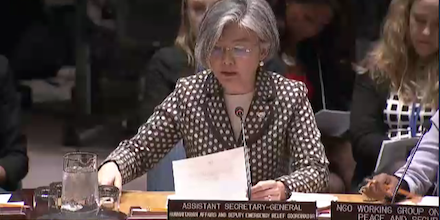Statement during January 2015 Security Council Open Debate on the Protection of Civilians in Armed Conflict:
“Another area of serious concern is the widespread use of explosive weapons in populated areas. Figures from 2013 show that when explosive weapons were used in populated areas, 93 per cent of the casualties were civilians. The Secretary-General’s call to avoid the use of some explosive weapons in populated areas has remained obviously unheeded.”
Statement during Security Council briefing on Syria, 28 January 2015:

ASG Kyung-wha Kang delivers statement to January 2015 civilian protection debate (UNTV)
“Syria is entering its fifth year of conflict characterized by extreme violence and brutality. Resolution 2139 called for an end to the indiscriminate employment of weapons in populated areas including shelling and aerial bombardment, and the use of barrel bombs. But the call continues to be ignored. The Government has continued to conduct airstrikes, including barrel bombs, in densely populated areas. Between 21 and 26 January, Government airstrikes on East Ghouta in Rural Damascus reportedly killed nearly 100 people and injured scores more. Armed opposition groups, and designated terrorist organizations, have also continued to use explosive weapons in populated areas. A barrage of around 50 rockets and mortars killed at least seven and injured 50 in Damascus city on 25 January.”
Statement to the Human Rights Council Special Session on Gaza, July 2014:
“Much more must also be done to protect civilians. The expansion of hostilities into built up areas and the use of explosive weapons in populated areas is deeply concerning. We know from experience that the use of such weapons gives rise to a predictable pattern of death, injury, displacement and damage or destruction of essential infrastructure.”
Statement during February 2014 Security Council Open Debate on the Protection of Civilians in Armed Conflict:
“Let me now turn to the protection of civilians from the use of explosive weapons in populated areas. As is apparent in Syria, Afghanistan, Iraq and Somalia, we must do more in that area. According to the British non-governmental organization Action on Armed Violence, almost 38,000 people were killed or injured by explosive weapons worldwide in 2012. Of those, 78 per cent were civilians. When explosive weapons were used in populated areas, 91 per cent of casualties were civilians. Last week, the United Nations Assistance Mission in Afghanistan reported a 14 per cent increase in civilian casualties in 2013, as compared to the previous year. The indiscriminate use of improvised explosive devices by anti-Government elements increased in 2013 and remained the leading cause of civilian casualties.
In addition to being killed or injured, civilians are also displaced, often for long periods and in precarious conditions. In Syria, 6.5 million people are internally displaced, and 2.5 million have fled the country. Many of those displaced have fled fighting characterized by the devastating and continuing use of explosive weapons in populated areas — all despite the Council’s calls for the removal of heavy weapons from population centres.
In the Sudanese states of Blue Nile and South Kordofan, aerial bombardment of civilian areas by Sudanese forces and shelling both by Sudanese forces and by the Sudan People’s Liberation Movement-North continue to result in death, injury and displacement.
Explosive weapons can result in horrific injuries requiring emergency and specialist medical treatment, rehabilitation and psychosocial support services. But often that treatment and support is unavailable, in part because health facilities have been damaged or destroyed. The International Committee of the Red Cross (ICRC), from which the Council will hear later, reports that explosive weapons are the leading cause of damage to health-care facilities in armed conflicts.
Explosive-weapon use in populated areas results in damage to, or the destruction of, housing and other infrastructure, such as schools. Approximately one third of the housing stock in Syria has been destroyed by the fighting, while nearly one fifth of the schools are either damaged or being used as shelters.
Livelihoods are also devastated as land and other means of production are rendered unusable as the result of explosive remnants of war, which will continue to pose a threat to civilians until they are removed. Damage to the agricultural sector during hostilities between Israel and Palestinian armed groups in Gaza from 14 to 21 November 2012 is estimated at $20 million. Moreover, explosive remnants of war remain buried in farmland and in the rubble of damaged buildings, posing a threat to people and those working on rubble-removal and reconstruction.
The Secretary-General has repeatedly called on parties to conflict to avoid the use of explosive weapons with wide-area effects in populated areas. He has asked the Office for the Coordination of Humanitarian Affairs to continue working with Member States, United Nations colleagues, the ICRC and civil society to strengthen the protection of civilians against such weapons. We will work to promote Member States’ recognition of the humanitarian impact of explosive-weapon use in populated areas and their commitment to avoid or limit such use in the future, including by building on good practice in that area. I hope that all Member States will engage in those efforts.”
Statement during the August 2013 Security Council Open Debate on the Protection of Civilians in Armed Conflict:
“We must consider measures to prevent and mitigate the humanitarian impact of the use in populated areas of explosive weapons which are by their nature indiscriminate within their areas of blast and fragmentation. We need to strengthen the protection of civilians from their effects. Discussions on this matter will take place next month.”
Statement during the May 2011 Protection of Civilians debate:
“Explosive weapons have an immediate and indiscriminate impact, killing and injuring those caught in the blast radius, including civilians, while the damage to buildings and infrastructure hampers longer term reconstruction and development. I reiterate my call on parties to conflict to refrain from the use of these weapons in densely populated areas.” View full statement
